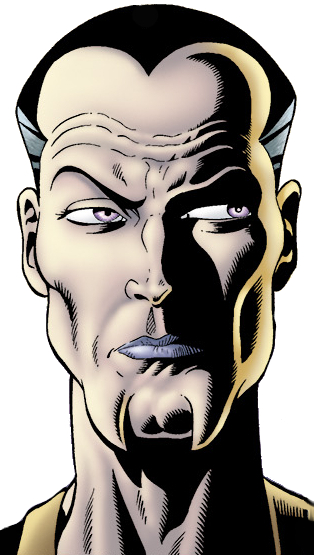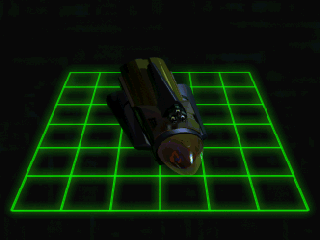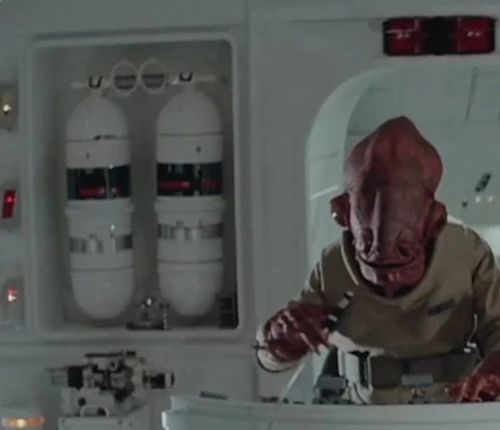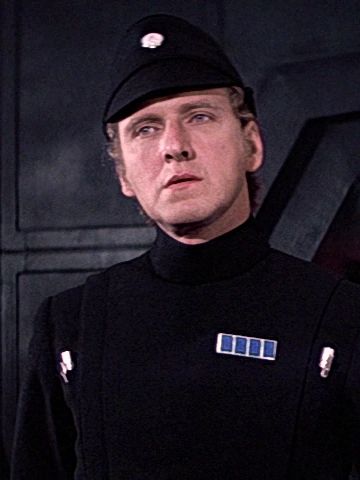Improving Droids
Improving a Droid takes three things : character points, money and time. Character points are always needed because Droids are thinking creatures, not dumb machines, who must use their skills, experience the universe and become aware of their possibilities before improving them. Unless the Droid learns a new skill by himself or is programmed by an associate, money is required to buy new software or to pay a teacher. Installing hardware or developing software for the Droid is time consuming.
The adaptability of Droids works differently than that of Humans and Aliens. Unlike Organics, Droids may improve their attributes and skills more than one pip at a time. Unlike them too, when an attribute of a Droid goes up, the skills under it are not affected.
Improving a Droid attributes.
The level of a Droid attribute depends entirely on the complexity of its hardware. The chips and mechanics that give a Droid a certain die code in a specific attribute are very complex and can only be manufactured by very few plants across the galaxy. Unless they are given access to very expensive machines, characters no matter how skilled they are will never be able to build these hardware pieces themselves.
Characters can however buy Droid attribute hardware and install it in their Droids or have it installed by specialists at an additional cost.
Die Code Cost Difficulty Time Required Availability
0D N/A Very Easy 1D hours N/A
0D+1 N/A Very Easy 1D+1 hours N/A
0D+2 N/A Very Easy 1D+2 hours N/A
1D 900 Easy 2D hours 2
1D+1 2100 Easy 2D+1 hours 2
1D+2 3600 Easy 2D+2 hours 2
2D 5400 Moderate 1D days 2
2D+1 7500 Moderate 1D+1 days 2
2D+2 9900 Moderate 1D+2 days 2
3D 12600 Difficult 2D days 3
3D+1 15600 Difficult 2D+1 days 3
3D+2 18900 Difficult 2D+2 days 3
4D 22500 Very Difficult 1D weeks 3,R
4D+1 26400 Very Difficult 1D+1 weeks 3,R
4D+2 30600 Very Difficult 1D+2 weeks 3,R
5D 35100 Heroic 2D weeks 4,X
5D+1 39900 Heroic 2D+1 weeks 4,X
5D+2 45000 Heroic 2D+2 weeks 4,X
Current technologies limit the "Die Code" of any attribute hardware to 5D+2.
"Cost" is the average price of the hardware raising one Droid attribute to "Die Code" on a space age planet. Prices should be lower on a planet with a Droid manufacturing plant and will definitely be higher on planets that haven't achieved space age technology.
"Difficulty" is the difficulty to beat with a Droid Programming/Repair roll in order to install that hardware. The character adds the number of dice he has in the attribute to the roll.
Example: Arnold (a kid) has 3D+2 Dexterity and 2D+2 Droid Programming/ Repair; when installing new dexterity hardware in R2rien, the party's astromech Droid, he adds 3 to his 2D+2 and thus rolls 2D+5.
"Time Required" is the normal duration of the task. If the character has access to the assembly-line for a comparable type of Droid, the time required is "Die Code" in hours. If they have access to the particular (unique in the Galaxy) assembly-line where the particular type of Droid is built, this time is further divided by three.
"Availability" lists where the hardware can be bought. The codes' meaning is given on page 161 of the second edition rulebook.
The number of character points the Droid must spend in order to have one of his attributes raised by one pip is only five times the number of dice of the current die code.
Example: Raising an attribute from 2D+2 to 3D costs 10 character points.
Unlike Humans and Aliens, Droids can have their attributes raised by several pips at a time provided they spend enough character points.
Example: R2rien has 2D Technical, in order to have it raised to 3D+1, he must spend 10 + 10 + 10 + 15 = 45 character points.
Unlike Human and Aliens, when an attribute of a Droid goes up, skills that are already higher than the new value do not change; skills that are lower than the new value are raised to that value.
Example: R2rien has 2D Mechanical, 3D Starship Piloting and 5D Astrogation; if his Mechanical was raised to 4D, his Starship Piloting would also be raised to 4D but his Astrogation would remain unchanged.
In order to change an attribute of a Droid, two rolls must be made: one to remove the old hardware and one to install the new one. The removal of hardware is done at the same difficulty and duration as the installation of hardware giving 1D less in the attribute.
Example: Arnold wants to improve the Droids Dexterity to 2D. He must first remove the original (1D) hardware which is a very easy task and takes him 1D hours and then install the new hardware in 1D days and that's a moderate task.
If more than one character works on the Droid, normal rules for combining actions apply. The results of the removal or installation of hardware are given in the table below. No character point is spent if the task fails.
roll >= diff Task succeeds.
roll < diff Task fails. The character may try again. Until fixed the Droid attribute is 0D.
2 x roll < diff Task fails. The hardware is damaged and no longer usable. Until fixed, the Droid attribute is 0D.
3 x roll < diff Task fails. Both the Droid and the hardware are damaged beyond repair.
Example : Arnold rolls 2D+5 and gets 4 and 6 (wild die, allowing him to re-roll a 4) for a total of 19 and removes the old Dexterity hardware of R2rien in 1 hour (1D hours). Installing the new Dexterity hardware will take Arnold 1D days. After six days, Arnold must make a moderate roll with 2D+5 and gets 2 and 1 (wild die) for a total of 5; unlucky Arnold has damaged the new hardware. Arnold removes it in 8 hours (2D hours) beating the easy difficulty with a 15 and barely puts the old hardware back in 7 hours (2D hours) with a roll of 8 (easy action). All this time, R2rien had his dexterity reduced to 0D but was otherwise able to act normally, i.e. astrogate.
Improving a Droid skills.
The skills of a Droid can be increased in several ways. Skills can be programmed into the Droid; characters can buy off the shelves products and simply run the installation script or develop the software themselves. Skills can also be taught to the Droid. Finally, the Droid can learn a skill by himself.
As with attributes, the skills of a Droid can be improved several pips at a time provided the Droid spends the required number of character points.
Buying a software package.
Skill software is sold on WORO (write-once, read-once) media only to prevent unlawful installation of the software on multiple Droids.
Die Code Cost Availability Die Code Cost Availability
7D 3420 3,R
1D+1 105 2 7D+1 3750 3,R
1D+2 180 2 7D+2 4095 3,R
2D 270 2 8D 4455 3,R
2D+1 375 2 8D+1 4830 3,R
2D+2 495 2 8D+2 5220 3,R
3D 630 2 9D 5625 4,R
3D+1 780 2 9D+1 6045 4,R
3D+2 945 2 9D+2 6480 4,R
4D 1125 2 10D 6930 4,R
4D+1 1320 2 10D+1 7395 4,R
4D+2 1530 2 10D+2 7875 4,R
5D 1755 3 11D 8370 4,X
5D+1 1995 3 11D+1 8880 4,X
5D+2 2250 3 11D+2 9405 4,X
6D 2520 3 12D 9945 4,X
6D+1 2805 3 12D+1 10500 4,X
6D+2 3105 3 12D+2 11070 4,X
Current technology limits the "Die Code" a Droid can acquire through programming to 12D+2.
"Cost" is the average price of a software package raising one Droid skill to "Die Code" on a space age planet. Prices should be lower on a planet with big software companies and will be higher on planets that haven't achieved space age technology.
"Availability" lists where the package can be bought. The codes' meaning is given on page 161 of the second edition rulebook.
The time required to install such a software varies from a few minutes to a maximum of one day.
The difficulty is normally Very Easy but each past attempt - successful or failed - to improve the corresponding attribute raises the difficulty by one. When the attribute has been raised by a specialist with adequate equipment, the difficulty is not modified.
Example: Arnold decides that he's going to raise R2rien's Dodge instead of his Dexterity; he could buy the software and make an Easy Droid Programming / Repair roll.
If the character fails the rolls, the Droid retains his current skill but the media is no longer usable. Characters may have specialists install the software for them at no such risk but at an additional cost.
The character points cost for raising a skill by one pip is only half the number of dice of the current die code rounded up.
Example: raising R2rien Astrogation skill from 5D to 6D would cost the Droid 3 + 3 + 3 = 9 character points.
Programming a Droid.
Characters can develop skill software themselves instead of buying it. Proficiency in the skill helps develop good software but is not required.
Die Time Die Time Die Time
Code Required Code Required Code Required
5D 4D weeks 9D 3D months
1D+1 1D days 5D+1 4D+1 weeks 9D+1 3D+1 months
1D+2 1D+2 days 5D+2 4D+2 weeks 9D+2 3D+2 months
2D 1D weeks 6D 5D weeks 10D 4D months
2D+1 1D+1 weeks 6D+1 5D+1 weeks 10D+1 4D+1 months
2D+2 1D+2 weeks 6D+2 5D+2 weeks 10D+2 4D+2 months
3D 2D weeks 7D 1D months 11D 5D months
3D+1 2D+1 weeks 7D+1 1D+1 months 11D+1 5D+1 months
3D+2 2D+2 weeks 7D+2 1D+2 months 11D+2 5D+2 months
4D 3D weeks 8D 2D months 12D 6D months
4D+1 3D+1 weeks 8D+1 2D+1 months 12D+1 6D+1 months
4D+2 3D+2 weeks 8D+2 2D+2 months 12D+2 6D+2 months
As was already observed, current technology limits the "Die Code" a Droid can acquire through programming to 12D+2.
"Time Required" is the time needed to develop a software giving the Droid "Die Code" in a skill. If more than one character is working on its development, a modified version of the Combined Actions rules (second edition rulebook, page 69) is used. The project leader rolls on the Command Difficulty table to find out how many characters could be commanded if they were available. The time needed is "Time Required" divided by the minimum of that number and the number of character really available.
Example: Arnold no longer has the money to buy the Dodge software so he's going to try to develop it with the help of his team-mates Alix and Vaurianne in order to raise R2rien Dodge skill to 4D. Sara, who owns the Droid, is not happy about it and wants to supervise the project. Alix has Droid Programming / Repair 2D, Arnold has 2D+2, Vaurianne has 3D+2 and Sarah has Command 2D+1. The average of Alix, Arnold and Sara's Droid Programming / Repair skill is close to 3D. With a roll of 14 (due to a lucky wild die) Sara beats a Moderate difficulty and could have co-ordinated the work of up to six characters; as only three are available, the project will take 1D weeks divided by 3.
Example: Assume that Sara rolls only 8: she would beat an Easy difficulty and only be able to co-ordinate the work of two characters. Alix, Arnold and Sarah will have to work full time for 1D weeks divided by 2. A lot of time is wasted because of bad decisions, sterile progress meetings or simply lack of co-ordination.
After the development time has elapsed, one character and the gamemaster make an opposed roll. The gamemaster rolls the new Die Code the character are trying to program into the Droid while the character rolls the average Die Code in Droid Programming / Repair of all the participants and adds the number of dice of the best character in the skill being programmed.
Example: Alix has Dodge 5D, Arnold has 5D+2 and Vaurianne has Dodge 3D+1. The average of their Droid Programming / Repair skill is closest to 2D+2, thus one of them should roll 2D+7.
The result of the software development is given by the table below where "G" is the Gamemaster's roll and "P", the player's :
VE E M D VD H New Die Code Debug
P >= G As expected
P < G <= P + 2 1 2 3 4 5 6 As expected 0.5
P + 2 < G <= P + 4 1 2 3 4 5 6 1 level lower 1.0
P + 4 < G <= P + 6 2 3 4 5 6 6 1 level lower 1.5
P + 6 < G <= P + 8 2 3 4 5 6 6 2 levels lower 2.0
P + 8 < G <= P + 10 3 4 5 6 6 6 2 levels lower 2.5
P + 10 < G <= P + 12 3 4 5 6 6 6 3 levels lower 3.0
P + 12 < G <= P + 14 4 5 6 6 6 6 3 levels lower 3.5
P + 14 < G <= P + 16 4 5 6 6 6 6 4 levels lower 4.0
P + 16 < G <= P + 18 5 6 6 6 6 6 4 levels lower 4.5
P + 18 < G <= P + 20 5 6 6 6 6 6 5 levels lower 5.0
P + 20 < G 6 6 6 6 6 6 5 levels lower 5.5
When the Droid Programming / Repair roll is not made, there will always be a chance when the Droid uses the skill that he will hit a bug, get caught in a loop, shut itself down, anything. "VE", "E", "M", "D", "VD" and "H" give the number that must be equalled or exceeded with a roll of one die every time the Droid uses the skill; if that roll is not made, something happen and the Droid simply cannot use the skill.
Example: The gamemaster rolls 4D and gets 17, Arnold rolls 2D+7 for a total of 13. Not entirely successful, but it could have been worse: R2rien Dodge is now 3D+2; furthermore every time the Droid tries something more complicated than a very easy Dodge, he may have problems.
Example: While under a tree in the jungle, R2rien spots a gadaji nut falling from the tree and tries to dodge it. The gamemaster rules that it is a moderate action and rolls 6; it is higher than 3, thus the Droid can attempt to Dodge the nut.
Example: A few days later, the party is ambushed by bounty hunters. Lacking fighting skills R2rien tries to flee and declares a full Dodge. One bounty hunter with a 6D Blaster is firing at him at medium range, the difficulty is 12 and he rolls 27. R2rien must roll 16 at least for his Dodge or he's hit by the bounty hunter. That correspond to a difficult Dodge; thus, unless the gamemaster rolls 4 or more on one die, R2rien shuts itself down and will not move until he is restarted. Of course, he will also be hit by the blast.
Fixing a bugged software is done through the same procedure except that the time required is not rolled; instead "Debug" is used as the result of each dice. Even though there is no guarantee that the fixed software will be free of bug, use of state of the art development method make sure that it will not get worse.
Example: the time required to fix R2rien Dodge ix 3 x 2 = 6 weeks. After 6 weeks, both the player and the gamemaster roll again. If the player rolls higher, R2rien Dodge software is fixed; he now has 4D. If the gamemaster does not beat the player by more than 3, some bugs have been fixed, but not all; R2rien Dodge is now 4D but he keeps failing from time to time. If the gamemaster beats the player by more than three, nothing changes.
The character points cost for raising a skill by one pip is only half the number of dice of the current die code rounded up. Having a bugged software fixed doesn't cost the Droid any character points. Restarting the software development from scratch sometimes takes less time than fixing the existing one but that costs the Droid more character points.
Example : a few month later, Arnold wants to raise R2rien Astrogation from 5D to 6D. After 5D weeks, the gamemaster rolls 6D for a total of 34. Arnold rolls 2D+2 and adds 3 to the roll (he has Astrogation 3D); he gets a 13 and changes that score into a 21 by spending 2 character points. R2rien has to spend 9 character points, his Astrogation is still 5D but fails from time to time now while it never did before. Arnold can either try to develop the software again in 5D weeks at the expense of 9 extra character points from R2rien or fix it in 5 x 3.5 = 17.5 weeks at no character point expense.
Teaching a skill to a Droid.
Because Droids are designed to learn from electronic stimuli and not from reading, lecture or training, they spend a lot more character points then Humans or Aliens when learning a skill from a teacher even another Droid or by themselves. Even when learning from another Droid, the teacher passes information to the other, not entire programs.
Like Organics, Droid can only learn a skill from someone who has at least the Die Code they want to achieve. Also, current technology of learning units imit the "Die Code" that can be acquired by this method to 7D.
The character points cost for raising a skill by one pip is three times the number of dice of the current die code.
Droids learn faster than Organics; in fact they often could learn faster than any Human or Alien could teach. When taught a new skill by an Organic, the time required to raise a skill by one pip is 2 days when their current skill level is 4D or less and 4 days when it's more than 4D. When taught by another Droid, it takes hours instead of days. Neither the teacher nor the Droid can spend character points to reduce this time.
Example: Vaurianne has Starship Piloting 6D+1, and wants to teach R2rien everything she knows about that skill. The Droid currently has 3D; they must spend 3 x 2 + 7 x 4 = 34 days together and R2rien must have and be ready to spend 3 x 9 + 3 x 12 + 3 x 15 + 6 = 114 character points.
Researching the skill.
Current technology of learning units limit the "Die Code" that can be acquired through this method to 7D.
The character points cost for raising a skill by one pip is four times the number of dice of the current die code.
The time required to raise a skill by one pip is 3 hours when the current skill level is 4D or less and 6 hours when it's more than 4D. That time cannot be reduced by spending extra character points.
Example: given access to a good source of information about computers, R2rien could raise his Computer Programming / Repair by one pip to 4D+1 in 6 hours if he spends 16 character points.
Specialists.
Specialists can install attribute hardware or skill software in your Droid or teach your Droid something they know. They can also be hired to develop skill software but the cost will generally be higher than the price you'd pay for an off the shelves package.
The fees of specialists vary widely from one place to another. On a space age planet, one may expect to pay 100 credits per day for a specialist with Droid Programming / Repair 5D to 7D+2, 400 credits when their skill is between 8D and 11D+2 and 1000 credits when their skill is higher than 12D.
Building your own Droid.
To build a Droid, a character must purchase the Droid frame which cost between 300 and 1000 credits. Droids with an unsophisticated frame like astromech or protocol Droids might cost 500 credits. Very simple Droid frames like the mouse Droids found all around on the Death Star are unlikely to cost more than 50 credits. As always the price can vary greatly with the place of purchase. The cost of special equipment should be added even if it is built into the frame, i.e. blasters for assassin Droids.
Let's compare the price of the four sample Droids described in section 8.2 of RPG2.
Build Buy
R2 Astromech Droid 21295 4525
9G Explorer Droid 7525 6700
K4 Security Droid 27100 7500
3PO Human-Cyborg Relation 20350 3000
"Build" is the cost to build the Droid; it includes the Droid frame, hardware for the six attributes and specific skill software. The price is lowered if the character develops the software himself.
"Buy" is the price of the Droid when bought from a Droid store on a space age planet.
Where does the difference come from? Droid manufacturers build billions of Droids; they get better prices on attribute hardware than any character would and have developed standard software that they install on the Droids at almost no cost.
When a character builds a new Droid, no matter what attribute hardware or skill software the character installs in it, the Droid will start with all attributes and all skills at 1D. When the Droid earns character points afterwards, they are automatically spent to bring his effective attributes and skills to their real Die Code. They are spent on attributes first, lower attributes being updated first; once all attributes have been brought up to their real Die Code, character points are spent on skills with lower skills being updated first.
Example: Rob O'Ward builds a //Ian (prononce "bar-bar-ian") fighter Droid with 4D Dexterity and Strength and 6D Blaster and Dodge. Assuming Rob makes the two Very Difficult rolls to install the two attribute hardware and two very easy ones to install the software, Knone (the name Rob gives it) will start with 1D in every attributes and skill. The first 5 character points Knone earns are automatically spent to bring his Dexterity or Strength (his choice) to 1D+1; the next 5 character points are automatically spent to bring the other to 1D+1. Once both attributes have reached 4D the same starts with skills; the next 2 character points Knone earns are spent to bring his Blaster or Dodge (his choice) to 4D+1 and so on until the two skills are at 6D.
Optional rule.
Gamemaster may allow characters to install new hardware and/or software in a Droid that doesn't have enough character points to spend for it. The Droid doesn't immediately become aware of its new possibilities; when he earns new character points they are automatically spent to bring the effective attributes and/or skills to their real level following the rules described above.
Example: Knone now has all attributes up to their real level, his Blaster is 5D and his Dodge 5D+1. Rob buys him new 2D Perception hardware; the next character points Knone earns will automatically be spent on it.
|











